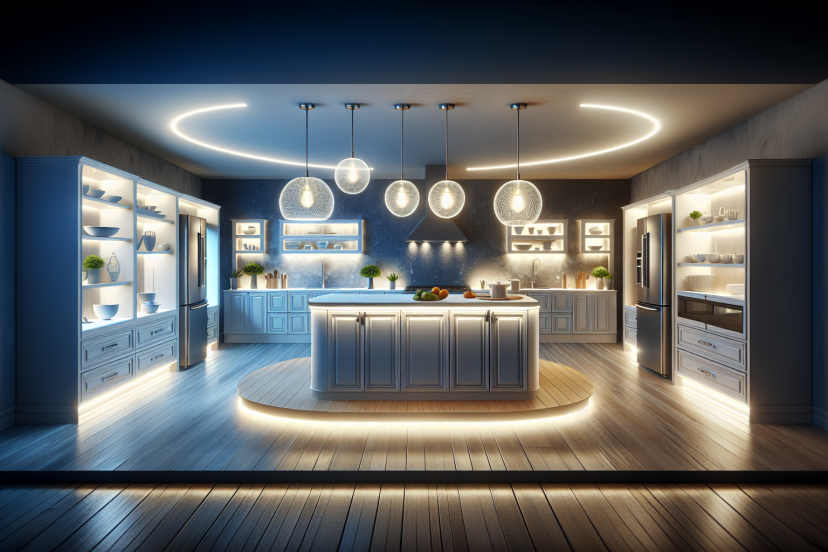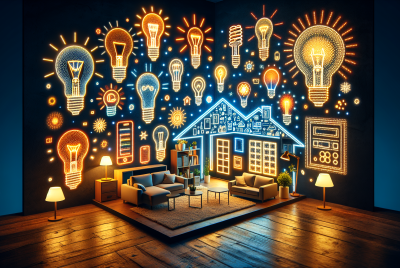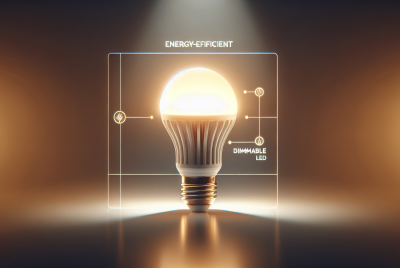Beginner’s Guide To Installing LED Lighting In Your Kitchen
Congratulations on taking the first step to transform your kitchen into a stunning space with LED lighting! In this beginner’s guide, we will walk you through the process of installing LED lighting in your kitchen, making it easier than ever to create a vibrant and modern culinary haven. From selecting the right fixtures to understanding the wiring and installation process, we’ve got you covered every step of the way. Get ready to bring a touch of brilliance to your kitchen with our comprehensive guide to installing LED lighting.
Choosing the Right LED Lights
Understanding Different LED Color Temperatures
When it comes to choosing LED lights for your kitchen, one important factor to consider is the color temperature. LED lights are available in a range of color temperatures, which are measured in Kelvin (K). Understanding the different color temperatures can help you create the desired ambiance in your kitchen.
For a warm and cozy atmosphere, you can opt for LED lights with a lower color temperature, typically ranging from 2700K to 3000K. These lights emit a soft, yellowish light, similar to traditional incandescent bulbs. They are ideal for areas where you want to create a relaxed and comfortable atmosphere, such as dining areas.
If you prefer a bright and invigorating environment, LED lights with a higher color temperature, typically ranging from 4000K to 5000K, are a great choice. These lights produce a cool, white light that mimics natural daylight. They are perfect for task-oriented areas in the kitchen, such as countertops and cooking stations, as they provide excellent visibility and clarity.
When selecting LED lights for your kitchen, you can also consider a middle-ground option with a color temperature around 3500K. These lights offer a balanced blend of warm and cool tones, creating a neutral and versatile lighting scheme.
Determining the Right Brightness
In addition to considering color temperature, it’s important to determine the right brightness level for your LED lights. The brightness of LED lights is measured in lumens, and the right brightness level depends on the size and layout of your kitchen, as well as your personal preferences.
For general ambient lighting in the kitchen, a good starting point is to aim for about 20 lumens per square foot. This means that if you have a kitchen that measures 100 square feet, you would need around 2,000 lumens of ambient lighting.
For task lighting, such as over the countertops or stove, you may want to aim for a higher brightness level. In these areas, you can aim for around 50 lumens per square foot. This will provide ample light for cooking, chopping, and other kitchen tasks.
Keep in mind that these are just general guidelines, and you can adjust the brightness levels based on your personal preferences and specific lighting needs.
Selecting the Appropriate LED Fixtures
Once you have determined the color temperature and brightness level for your LED lights, the next step is to select the appropriate fixtures. LED lights come in various forms, including recessed lights, strip lights, pendants, and under-cabinet lights.
Recessed lights are a popular choice for kitchen lighting, as they provide a sleek and minimalist look. They are installed directly into the ceiling, creating a seamless and integrated lighting solution. Recessed lights are ideal for general ambient lighting, and they can be strategically placed to illuminate specific areas of the kitchen.
LED strip lights are another versatile option for kitchen lighting. They can be mounted under cabinets or along the toe kicks, providing both functional and decorative lighting. Strip lights are great for task lighting and creating a soft glow that adds visual interest to the space.
If you prefer a more decorative and statement lighting option, LED pendant lights are a great choice. They can be installed over the kitchen island or dining table, adding an elegant touch to your kitchen. Pendant lights come in a variety of styles and designs, allowing you to find the perfect match for your kitchen decor.
Under-cabinet lights are a practical choice for illuminating the workspaces in your kitchen. They can be installed underneath the upper cabinets, providing direct light onto the countertops. Under-cabinet lights are a must-have for task-oriented areas, ensuring clear visibility while cooking or preparing meals.
Considering Dimming Options
To further enhance the flexibility and ambiance of your kitchen lighting, consider choosing LED lights that are compatible with dimming options. Dimmable LED lights allow you to easily adjust the brightness levels to create different moods and atmospheres in your kitchen.
With dimmable LED lights, you can easily brighten the space for cooking and food preparation, and then dim the lights for a more relaxed and intimate setting during meals or gatherings. Dimming options can also help save energy and extend the lifespan of your LED lights.
When selecting dimmable LED lights, it’s important to ensure compatibility with the dimmer switches or systems you plan to use. Not all LED lights are dimmable, so make sure to check the product specifications before making a purchase. Additionally, consider investing in quality dimmer switches that are specifically designed for LED lighting to ensure smooth and flicker-free dimming performance.
Calculating Lighting Requirements
Assessing Kitchen Size and Layout
Before you start installing LED lighting in your kitchen, it’s important to assess the size and layout of the space. Understanding the dimensions and configuration of your kitchen will help you determine the optimal placement of lights and calculate the lighting requirements.
Measure the length and width of your kitchen to determine the square footage. This will be useful when calculating the total lumens needed for ambient lighting. Additionally, take note of any architectural features, such as islands, cabinets, or shelves, that may affect the distribution of light.
Determining the Illumination Levels
To ensure proper illumination in your kitchen, it’s important to determine the appropriate levels of light for different areas. This will help you create a well-lit and functional space that meets your specific needs.
For general lighting, aim for a uniform illumination level of around 20-30 foot-candles throughout the kitchen. Foot-candles are a unit of measurement that indicates the amount of light reaching a surface. To calculate the total lumens needed for ambient lighting, multiply the square footage of your kitchen by the desired illumination level.
For task-oriented areas, such as countertops or stove, you may want to increase the illumination level to around 50-70 foot-candles. This will provide ample light for various cooking and food preparation tasks.
Identifying Task Lighting Zones
To achieve optimal task lighting in your kitchen, it’s important to identify the specific areas that require focused illumination. This will ensure that you have adequate light for performing tasks such as cutting, chopping, or reading recipes.
Common task lighting zones in the kitchen include the countertop areas, stove, sink, and any other work surfaces you regularly use. Take note of these areas and plan for dedicated task lighting solutions, such as recessed lights or under-cabinet lights, to provide sufficient light in those zones.
Planning for Ambient Lighting
In addition to task lighting, ambient lighting plays a crucial role in creating a warm and inviting atmosphere in your kitchen. Ambient lighting refers to the general illumination of the space and is typically achieved through overhead lights or a combination of recessed lights and pendant lights.
Consider the overall aesthetics and functionality of your kitchen when planning for ambient lighting. For example, if you have a kitchen island, installing pendant lights above it can serve as both a functional and decorative lighting solution. Similarly, recessed lights strategically placed throughout the kitchen can provide uniform ambient lighting.
To create a layered lighting design, consider incorporating different lighting techniques, such as wall sconces or spotlights, to highlight architectural features or artwork. This will add depth and visual interest to your kitchen while enhancing the overall lighting ambiance.
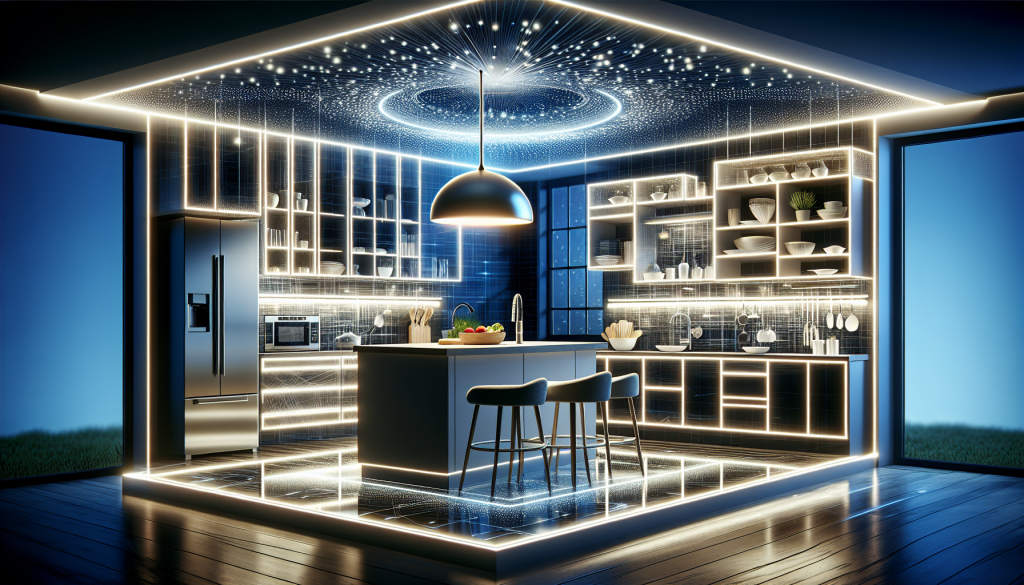
Preparing Your Kitchen for LED Installation
Checking Existing Wiring and Circuits
Before installing LED lights in your kitchen, it’s important to check the existing wiring and circuits to ensure they can support the new lighting fixtures. This step is crucial for safety and to prevent any electrical issues or overload.
Start by turning off the power to the kitchen lighting circuit at the main electrical panel. Then, carefully remove the existing light fixtures to inspect the wiring behind them. Ensure that the wiring is in good condition, without any signs of damage or fraying.
If you are unsure about the condition of your wiring or if it needs to be upgraded, consult a licensed electrician who can assess and make any necessary modifications or repairs. It’s important not to proceed with the LED installation if there are any concerns about the safety or compatibility of the electrical wiring.
Ensuring Proper Insulation and Ventilation
Another aspect to consider when preparing your kitchen for LED installation is the insulation and ventilation. LED lights produce much less heat compared to traditional incandescent or halogen bulbs, but proper insulation and ventilation are still important for maintaining optimal performance and longevity.
Inspect the insulation in the ceiling or walls where the LED lights will be installed. Ensure that there is adequate space around the fixtures for proper airflow and heat dissipation. If needed, adjust or add insulation to create a suitable environment for the LED lights.
Additionally, check for any obstructions or debris in the area where the LED lights will be installed. Clear away any objects or materials that could potentially block the airflow or cause overheating.
Measuring and Marking Light Fixture Positions
To ensure a precise installation of your LED lights, it’s important to measure and mark the positions where the fixtures will be installed. This will help create a uniform and visually pleasing lighting arrangement in your kitchen.
Using a measuring tape, mark the desired locations for your LED lights. Consider the layout and configuration of your kitchen, as well as any specific lighting requirements for task areas or architectural features. Use a pencil or marker to clearly mark the positions on the ceiling or walls, ensuring that they align with your design vision.
If you are unsure about the placement of your LED lights, you can create a mock-up by using tape or cardboard cutouts to visualize the final positioning and spacing. This will allow you to make any adjustments or modifications before proceeding with the actual installation.
Clearing the Work Area
Before you begin installing your LED lights, it’s important to clear the work area to ensure a safe and unobstructed installation process. Remove any furniture, decor items, or appliances that may interfere with the installation or pose a risk of damage.
Clearing the work area will also provide you with ample space and visibility to work efficiently. It’s important to have a clutter-free environment to avoid any accidents or mishaps during the installation process.
Take the time to organize your tools and materials in a designated area nearby. This will make it easier to access what you need and keep everything within reach as you work on the LED installation.
Gathering the Necessary Tools and Materials
To successfully install LED lighting in your kitchen, it’s important to gather all the necessary tools and materials beforehand. Having everything you need readily available will help streamline the installation process and ensure a smooth and efficient workflow.
LED Lights
The first and most important item you will need is the LED lights themselves. Choose the appropriate type and style of LED lights based on your lighting requirements and design preferences. Make sure to purchase lights that are compatible with the dimming options, if desired.
Light Fixtures
Depending on the type of LED lights you chose, you may also need additional light fixtures, such as recessed housings, pendant light kits, or under-cabinet light fixtures. Ensure that the fixtures are suitable for the LED lights you have selected and comply with safety regulations.
Wire Cutters and Strippers
Wire cutters and strippers are essential tools for cutting and preparing electrical wires during the installation process. They allow you to trim and remove the outer covering of the wires to expose the conductor and ensure secure connections.
Wire Connectors
Wire connectors, also known as wire nuts, are used to join and secure electrical wires together. They provide a reliable and insulated connection, preventing any loose or exposed wires that could lead to electrical issues.
Electrical Tape
Electrical tape is a versatile tool that is used to insulate and protect electrical connections. It helps ensure that the wires are securely connected and protected from any potential damage or moisture.
Screwdrivers and Screws
Screwdrivers of various sizes and types will be needed for mounting LED fixtures and securing them in place. Choose the appropriate screws that are suitable for the type of fixture you are installing and the material of the mounting surface.
Drill and Drill Bits
A drill and drill bits will come in handy when making necessary cutouts and holes for recessed lights or mounting brackets. Make sure to use the appropriate drill bit size for the specific task and material.
Ladder or Step Stool
Depending on the height of your ceiling or the installation area, you may need a ladder or step stool to safely reach and install the LED lights. Ensure that the ladder or step stool is stable and properly positioned before climbing on it.
Safety Equipment
Safety should be a top priority during any electrical installation. Make sure to wear safety goggles to protect your eyes from debris or dust, as well as gloves to avoid any cuts or injuries. If necessary, use a mask to prevent inhaling any dust or particles.
With all the necessary tools and materials gathered, you can confidently proceed with the LED lighting installation in your kitchen.
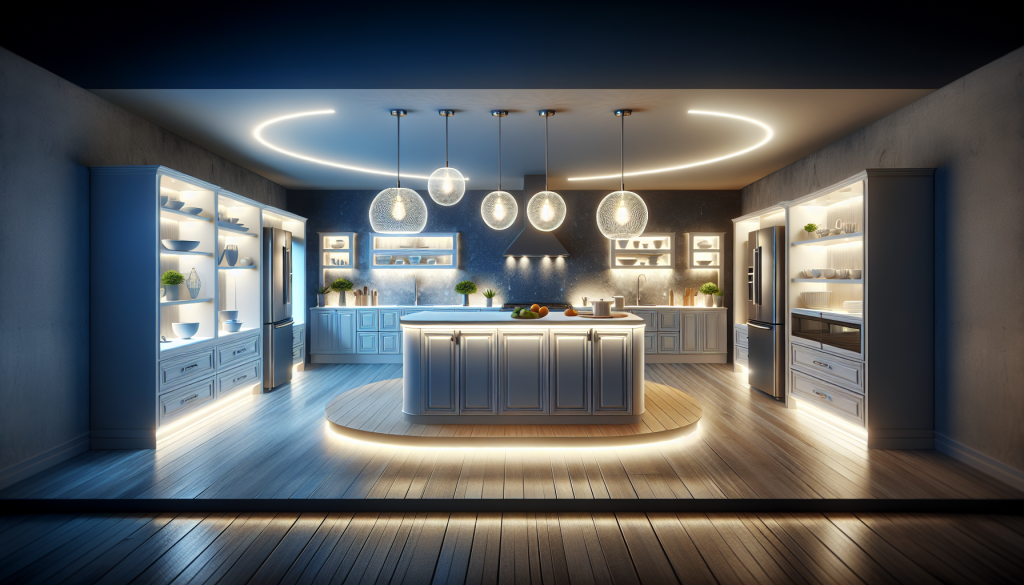
Installing LED Recessed Lights
Finding the Appropriate Locations
To install LED recessed lights in your kitchen, start by determining the appropriate locations for the fixtures. Consider the layout and size of your kitchen, as well as the specific lighting requirements for different areas.
Typically, recessed lights are installed in a grid-like pattern, creating an even and uniform distribution of light. Measure and mark the positions for each recessed light, ensuring that they are equally spaced and aligned with your design vision.
Making Required Cutouts
Once you have marked the positions for the recessed lights, it’s time to make the necessary cutouts in the ceiling. Use a drill and the appropriate drill bit to create a pilot hole in the center of each marked position. This will guide you when cutting the larger hole.
Next, use a keyhole saw or a drywall saw to cut along the marked circles, following the guidelines created by the pilot holes. Take your time and work carefully to ensure clean and precise cutouts. Remove any excess drywall or debris from the cutouts.
Wiring the Lights
After the cutouts are complete, it’s time to wire the recessed lights. Turn off the power to the lighting circuit at the main electrical panel to avoid any electrical hazards during the installation process.
Start by running electrical cables from the existing electrical box to each recessed light location. Make sure to leave enough slack in the cables for easy connection and positioning of the lights.
Strip the outer insulation of the electrical cables using wire strippers, exposing the individual wires. Connect the black wire from the electrical box to the black wire of each recessed light, and secure them together using a wire connector. Repeat this process for the white wires and the ground wires.
Securely Installing the Recessed Lights
Once the wiring is complete, it’s time to install the recessed lights in the cutouts. Position each light fixture into its respective cutout, ensuring that the wires are not tangled or pinched.
Most recessed lights come with mounting brackets that secure the fixtures in place. Follow the manufacturer’s instructions to attach the brackets, making sure they are securely fastened to the ceiling or joists.
Once the brackets are in place, gently push the recessed light into the cutout, ensuring that it is seated properly. Some recessed lights come with adjustable clips or springs that help secure the fixture in place. Adjust these clips or springs as needed to ensure a snug fit.
Testing the Connection
After installing all the recessed lights, it’s important to test the connection to ensure everything is working properly. Turn on the power to the lighting circuit at the main electrical panel and flip the light switches associated with the recessed lights.
Check if all the recessed lights turn on and off as expected. Observe any flickering or dimming issues, which may indicate a wiring or compatibility problem. If any issues are detected, turn off the power and double-check the wiring connections and dimmer compatibility.
With the recessed lights successfully installed and tested, you can now enjoy the enhanced lighting in your kitchen.
Mounting LED Strip Lights Under Cabinets
Positioning the Strips
Mounting LED strip lights under cabinets is a popular choice for adding functional and decorative lighting to your kitchen. Start by determining the positioning of the strip lights, taking into consideration the length and placement of the cabinets.
Measure the length of the cabinet where you plan to install the LED strip lights. Cut the strip lights to the desired length, following the manufacturer’s instructions. Most LED strip lights can be cut at specific intervals, usually marked by designated cut points.
Cleaning and Preparing the Cabinet Surfaces
Before attaching the LED strip lights, it’s important to clean and prepare the cabinet surfaces to ensure a secure and long-lasting bond. Wipe the area where the strip lights will be mounted with a mild cleaner or rubbing alcohol to remove any dirt, grease, or debris.
Dry the surfaces thoroughly to ensure that there is no moisture or residue remaining. This will provide a clean and optimal surface for the adhesive backing of the LED strip lights.
Attaching the LED Strips
LED strip lights typically come with a self-adhesive backing for easy installation. Carefully peel off the adhesive backing from the strip lights and position them along the cleaned and prepared cabinet surface. Press firmly to ensure a strong bond between the strip lights and the cabinet.
Take your time to align the strip lights properly and ensure a straight and even placement. You can use a level or ruler as a guide to ensure accuracy. If needed, you can also use additional adhesives or mounting clips for added security or stability.
Connecting Power Supply and Wiring
Once the LED strip lights are securely attached, it’s time to connect the power supply and wiring. LED strip lights typically require a power supply or transformer to convert the electricity and provide the necessary voltage.
Follow the manufacturer’s instructions to connect the power supply to the strip lights. Make sure to match the positive (+) and negative (-) terminals accordingly to ensure proper functionality. Secure the connections with wire connectors or electrical tape to prevent any loose or exposed wires.
Concealing Wires
To create a clean and seamless look, consider concealing the wires of the LED strip lights. Depending on the design of your cabinets, there are several options for hiding or camouflaging the wires.
One common method is to use wire channels or raceways that can be attached along the underside or back of the cabinets. These channels provide a neat and organized way to run the wires while keeping them hidden from view.
Another option is to drill small holes in the cabinet or use existing cable holes to route the wires through. This can be a more discreet and hidden approach, especially if the cabinets have internal shelves or compartments.
Ensure that the wires are safely tucked away and not exposed to any potential hazards, such as moisture or sharp edges. Make sure to test the LED strip lights after concealing the wires to ensure everything is working properly.
With the LED strip lights successfully mounted under your cabinets, you can now enjoy the added functionality and ambiance they bring to your kitchen.
Replacing Existing Fixtures with LED Pendants
Removing Old Fixtures
If you already have existing fixtures in your kitchen, replacing them with LED pendant lights can bring a fresh and updated look to the space. Start by turning off the power to the lighting circuit at the main electrical panel to ensure safety during the replacement process.
Remove the screws or fasteners that hold the existing fixtures in place. Carefully detach the fixtures from the ceiling or wall, ensuring that you support the weight and prevent any damage or falling fixtures.
Once the fixtures are removed, disconnect the electrical wires that are connected to them. Make note of the wiring connections before disconnecting them to ensure a smooth installation of the LED pendant lights.
Prepping the Ceiling or Wall
Before installing the LED pendant lights, it’s important to prepare the ceiling or wall surface to ensure a secure and stable installation. Repair any holes, cracks, or damage on the surface for a smooth and even mounting.
If needed, paint or touch up the ceiling or wall to match the new LED pendant lights or to enhance the aesthetics of the space. Allow sufficient time for the paint or touch-up to fully dry before proceeding with the installation.
Installing the Pendant Lights
Follow the manufacturer’s instructions to install the LED pendant lights in the desired locations. This typically involves attaching the pendant light fixtures to a ceiling or wall mount, which can vary depending on the style and design of the lights.
Securely fasten the pendant lights to the mounting brackets or hardware, ensuring that they are level and aligned with your design vision. Use a level to ensure an accurate and straight placement.
Connecting Wiring and Securing
After the pendant lights are installed, it’s time to connect the electrical wiring. Match the corresponding wires from the pendant lights to the existing electrical wires in the ceiling or wall. Connect the wires securely using wire connectors, ensuring a tight and insulated connection.
For safety and to prevent any loose wires, it’s important to secure the connections inside the electrical boxes. Ensure that the wire connectors are properly twisted and tucked inside the boxes, without any exposed or dangling wires.
Adjusting Height and Leveling
Once the pendant lights are connected, you can adjust the height and leveling to achieve the desired look and functionality. Most LED pendant lights come with adjustable cables or rods that allow you to fine-tune the height.
Measure and adjust the length of the cables or rods to ensure that the pendant lights are hanging at the desired height. Use a level to ensure that the lights are straight and aligned with each other.
Attaching Shades or Covers
If your LED pendant lights come with shades or covers, attach them according to the manufacturer’s instructions. Shades or covers not only add a decorative touch but also help diffuse the light and create a pleasant and comfortable ambiance.
Ensure that the shades or covers are securely fastened and properly aligned with the pendant lights. Double-check the connections and the overall stability of the pendant lights before turning on the power.
With the LED pendant lights successfully installed, you can now enjoy the updated and stylish lighting in your kitchen.
Adding LED Under-Cabinet Lighting
Choosing the Right Under-Cabinet Lights
Adding LED under-cabinet lighting is a practical and aesthetically pleasing way to enhance the functionality and ambiance of your kitchen. When selecting under-cabinet lights, consider the style, brightness, and color temperature that will best suit your kitchen decor and lighting needs.
Under-cabinet lights come in various forms, including LED light bars, puck lights, and tape lights. Light bars provide bright and even illumination along the entire length of the cabinet, while puck lights offer focused and directional lighting. Tape lights are flexible and versatile, allowing you to create custom lighting designs.
Choose under-cabinet lights that are specifically designed for kitchen use, as they are typically more durable and resistant to moisture and heat. Look for lights with adjustable brightness levels and color temperatures to create the desired lighting ambiance.
Measuring and Planning Light Placement
Before installing the under-cabinet lights, it’s important to measure and plan the placement to ensure even and effective illumination. Start by measuring the length of the cabinets where you intend to install the lights.
For LED light bars or tape lights, plan to install them along the front edge of the cabinets, positioning them towards the backsplash and countertop. Measure and mark the positions for each light, ensuring equal spacing and alignment with the cabinet edges.
For puck lights, plan to install them underneath the cabinets, focusing the light towards the countertop. Measure and mark the positions for each light, ensuring that they are evenly distributed and aligned.
Wiring the LED Lights
Once you have planned the light placement, it’s time to wire the under-cabinet lights. Turn off the power to the lighting circuit at the main electrical panel to ensure safety during the installation process.
Start by running electrical cables from the existing electrical box to each light location. Make sure to leave enough slack in the cables for easy connection and positioning of the lights.
Strip the outer insulation of the electrical cables using wire strippers, exposing the individual wires. Connect the black wire from the electrical box to the black wire of each under-cabinet light, and secure them together using a wire connector. Repeat this process for the white wires and the ground wires.
Securing and Mounting the Lights
With the wiring complete, it’s time to secure and mount the under-cabinet lights. Follow the manufacturer’s instructions to attach the lights to the designated mounting brackets or hardware.
For LED light bars or tape lights, use the provided mounting clips or adhesive backing to secure the lights along the front edge of the cabinets. Ensure that the lights are straight and aligned with the cabinet edges for a polished and professional look.
For puck lights, use the supplied screws to attach them underneath the cabinets. Make sure to position the lights towards the countertop to provide optimal task lighting. Secure the lights tightly to prevent any movement or misalignment.
Testing and Adjusting the Lighting
After mounting all the under-cabinet lights, it’s important to test the lighting and make any necessary adjustments. Turn on the power to the lighting circuit at the main electrical panel and use the light switches associated with the under-cabinet lights to activate them.
Check if all the lights turn on and off as expected. Observe the brightness and color temperature, ensuring that they meet your lighting preferences and needs. If any issues are detected, turn off the power and double-check the wiring connections and light settings.
With the LED under-cabinet lights successfully installed, you can now enjoy the enhanced visibility and ambiance they bring to your kitchen workspace.
Setting Up LED Track Lighting
Determining Track Layout
LED track lighting offers a flexible and versatile lighting solution for your kitchen. Start by determining the track layout, considering the size and configuration of your kitchen, as well as your lighting needs.
Track lighting typically consists of a straight or curved track that holds multiple adjustable light fixtures. Measure the length and width of your kitchen to determine the appropriate size and shape of the track.
Consider the areas in your kitchen that require focused illumination, such as countertops, kitchen islands, or dining areas. Plan the track layout accordingly, ensuring that the lights are evenly distributed and aligned with the target areas.
Installing the Track and Electrical Components
Once you have determined the track layout, it’s time to install the track and electrical components. Turn off the power to the lighting circuit at the main electrical panel before starting any installation work.
Start by positioning the track along the chosen layout, ensuring that it is level and aligned with your design vision. Use a level to guide you and make adjustments as needed. Secure the track to the ceiling or wall using the provided screws or mounting brackets.
Next, connect the electrical components, such as the power feed and any necessary connectors or joiners, according to the manufacturer’s instructions. Ensure that the connections are secure and properly insulated to prevent any electrical issues.
Attaching LED Track Heads
Once the track is installed and the electrical components are connected, it’s time to attach the LED track heads. Follow the manufacturer’s instructions to install the track heads onto the track, ensuring that they are evenly spaced and aligned.
LED track heads typically have adjustable arms or swivel mechanisms that allow you to direct the light wherever it is needed. Position the track heads towards the desired areas, such as countertops or kitchen islands, to provide optimal task lighting.
Adjust the track heads as needed to achieve the desired illumination angles and coverage. Make sure to tighten the adjustment mechanisms to prevent any unintentional movement or misalignment.
Connecting Wiring and Power
With the track heads in place, it’s time to connect the wiring and power supply. Start by turning off the power to the lighting circuit at the main electrical panel to ensure safety during the installation process.
Run electrical cables from the existing electrical box to the track location, ensuring that there is enough slack for connection and positioning. Strip the outer insulation of the electrical cables using wire strippers, exposing the individual wires.
Connect the black wire from the electrical box to the black wire of the track, and secure them together using wire connectors. Repeat this process for the white wires and the ground wires.
Testing the Lighting
After completing the wiring connections, it’s important to test the LED track lighting to ensure everything is working properly. Turn on the power to the lighting circuit at the main electrical panel and use the light switches associated with the track lighting to activate it.
Check if all the track lights turn on and off as expected. Observe the brightness and flexibility of the lighting, ensuring that it meets your specific lighting needs. Adjust the track heads and make any necessary changes to achieve the desired illumination angles and coverage.
With the LED track lighting successfully set up, you can now enjoy the adaptable and customizable lighting in your kitchen.
Troubleshooting LED Lighting Installation
Checking Power Supply and Connections
If you encounter any issues with your LED lighting installation, start by checking the power supply and connections. Ensure that the lighting circuit is properly powered and that the switches are turned on.
Make sure that the electrical connections are secure and properly insulated. Double-check the wiring connections, ensuring that the positive and negative terminals are correctly matched. Use wire connectors or electrical tape to securely fasten the connections and prevent any loose or exposed wires.
Resolving Flickering or Dimming Issues
If you experience flickering or dimming issues with your LED lights, there are a few potential causes and solutions to consider. Flickering or dimming lights can be caused by incompatible dimmer switches, improper wiring connections, or low-quality LED lights.
Ensure that the dimmer switches you are using are compatible with LED lights. Not all LED lights are dimmable, so make sure to check the product specifications before making a purchase.
Double-check the wiring connections, ensuring that the wires are properly connected and secured. Loose or faulty connections can cause flickering or dimming issues.
If you suspect low-quality LED lights, consider replacing them with higher-quality ones. Low-quality lights may not have proper voltage regulation or circuitry, leading to flickering or inconsistent performance.
Addressing Uneven Lighting
If you notice uneven lighting in your kitchen after installing LED lights, there are a few steps you can take to address the issue. Uneven lighting can be caused by improper placement or spacing of the lights, inadequate brightness levels, or light beam angles.
Reposition or adjust the lights to ensure even distribution and coverage. Consider moving or adding lights to areas that are underlit or shadowed.
If the lights are not bright enough, you may need to increase the brightness levels. This can be achieved by replacing the existing lights with higher-lumen options or adding additional lights to increase overall illumination.
Evaluate the light beam angles of the fixtures. Make sure that the lights are directing the light at the desired areas and that the beam spreads evenly across the surface.
Troubleshooting Color Temperature Problems
If you are unhappy with the color temperature of your LED lights, there are a few solutions to consider. Color temperature problems can arise from using lights with the wrong color temperature or from improper placement.
If the lights are too warm or cool for your liking, consider replacing them with lights that have a different color temperature. LED lights are available in a range of color temperatures, allowing you to find the perfect match for your preferences.
Reposition or adjust the lights to achieve the desired color temperature. The perception of color temperature can be influenced by the proximity and angle of the lights. Experiment with different placements to find the optimal arrangement.
By troubleshooting any issues that arise during the LED lighting installation process, you can ensure that your kitchen lighting meets your expectations and provides both functionality and aesthetics.
Installing LED lighting in your kitchen is a great way to enhance its functionality, ambiance, and energy efficiency. By understanding different LED color temperatures, determining the right brightness levels, selecting appropriate fixtures, and considering dimming options, you can create a customized lighting scheme that meets your specific needs and design preferences.
Calculating the lighting requirements involves assessing the kitchen size and layout, determining the illumination levels, identifying task lighting zones, and planning for ambient lighting. By taking into account these factors, you can ensure that your kitchen is properly illuminated for various activities and tasks.
Preparing your kitchen for LED installation involves checking existing wiring and circuits, ensuring proper insulation and ventilation, measuring and marking light fixture positions, and clearing the work area. By addressing these preparatory steps, you can create a safe and efficient environment for the LED lighting installation process.
Gathering the necessary tools and materials before starting the installation is essential for a smooth workflow. LED lights, light fixtures, wire cutters and strippers, wire connectors, electrical tape, screwdrivers and screws, drill and drill bits, a ladder or step stool, and safety equipment should all be available to ensure a successful installation.
Different types of LED lighting installations require specific steps and considerations. Installing LED recessed lights involves finding appropriate locations, making required cutouts, wiring the lights, securely installing the recessed lights, and testing the connection. Mounting LED strip lights under cabinets requires positioning the strips, cleaning and preparing the cabinet surfaces, attaching the LED strips, connecting the power supply and wiring, and concealing the wires. Replacing existing fixtures with LED pendants involves removing old fixtures, prepping the ceiling or wall, installing the pendant lights, connecting wiring and securing, adjusting height and leveling, and attaching shades or covers. Adding LED under-cabinet lighting requires choosing the right under-cabinet lights, measuring and planning light placement, wiring the LED lights, securing and mounting the lights, and testing and adjusting the lighting. Setting up LED track lighting involves determining track layout, installing the track and electrical components, attaching LED track heads, and connecting wiring and power.
Troubleshooting LED lighting installation may be necessary to address any issues that arise. Checking power supply and connections, resolving flickering or dimming issues, addressing uneven lighting, and troubleshooting color temperature problems are important steps in ensuring an optimal LED lighting experience.
By following this beginner’s guide to installing LED lighting in your kitchen and carefully considering each step and consideration, you can transform your kitchen into a well-lit and inviting space that meets your specific lighting needs and enhances your overall kitchen experience.

